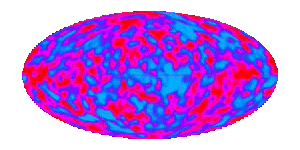

1934:
Richard Tolman shows that blackbody radiation in an expanding universe cools,
but retains its thermal distribution and remains a blackbody.
1941:
Andrew McKellar uses the excitation of CN doublet lines to measure that the
"effective temperature of space" is about 2.3°K. [CN is the cyanide or nitrile radical]
1948:
George Gamow, Ralph Alpher, and Robert Herman predict
that a Big Bang universe will have a blackbody cosmic microwave background with temperature about 5°K.
1955:
Tigran Shmaonov finds excess microwave emission with a temperature of roughly 3°K.
So do several other researchers, starting with Andrew McKellar's 1941 observations of the excitation of interstellar CN molecules,
but they do not follow through sufficiently, until Penzias and Wilson in 1964.
1964:
A.G. Doroshkevich and Igor Novikov write an unnoticed paper suggesting microwave searches for the blackbody radiation
predicted by Gamow, Alpher, and Herman.
1965:
Arno Penzias and Robert Wilson discover the 3°K cosmic microwave background radiation.
Through the connection of Bernie Burke, Robert Dicke, James Peebles, Roll, and Wilkinson,
they learn about and interpret the measurement.
See The Nobel Prize in Physics 1978
(Nobel Foundation)
1966:
Rainer Sachs and Arthur Wolfe theoretically predict microwave background fluctuation amplitudes
created by gravitational potential variations between observers and the "last scattering surface".
1968:
Martin Rees and Dennis Sciama theoretically predict microwave background fluctuation amplitudes
created by photons traversing time-dependent potential wells.
1969:
R.A. Sunyaev and Yakov Zel'dovich study the inverse Compton scattering of
microwave background photons by hot electrons.
1990:
The COBE satellite shows that
the microwave background has a nearly perfect blackbody spectrum
and thereby strongly supports the hot Big Bang model and the thermal history of the Universe,
and constrains the density of the intergalactic medium.
1992:
The COBE satellite discovers
anisotropy in the cosmic microwave background, this strongly supports the Big Bang model,
with gravitational instability as the source of large scale structure.
This discovery energizes and motivates the field in both theory and experiment, leading to an explosion of activity.
2001:
MAP (Microwave Anisotropy Probe) to be launched as a NASA MidEX mission.
2006:
"For their discovery of the blackbody form and anisotropy of the cosmic microwave background radiation",
John C. Mather and George F. Smoot, Nobel Prize in Physics 2006
(Nobel Foundation).
See
The Nobel Prize in Physics 2006
(.pdf).
2007:
Planck
(Max Planck Surveyor formerly known as COBRAS/SAMBA) to be launched as an ESA (European Space Agency) Mission.
The original information for this page can be found at
Cosmic Microwave Background Timeline,
in the Cosmic Microwave Background Astrophysics Research Program Web site
![]() Updated: October 3 '06
Updated: October 3 '06
Best seen with MS Internet Explorer.
Back to: The Cosmic Microwave Background Radiation